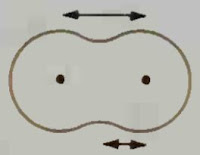English Language
The radius of an atom is the distance from the center of the nucleus to the outermost electrons. The atomic radius is determined by measuring the bond length (the distance between nuclei) in a covalent compound such as CI —CI or H—H and dividing by two. Therefore, atomic radii are often called covalent radii. Values for atomic radii are usually given in Angstroms (Å), where 1 Å = 10-8 cm
Atomic radii vary depending on the extent of attraction between the nucleus and its electrons. The greater the attraction, the smaller is the atomic radius. What factors affect this attraction? The most important factors are the number of protons in the nucleus and the number of shells containing electrons.
bond length = 0,78 Å
atomic radius = 0,37 Å
A nucleus with a greater number of protons has a greater attraction for its electrons, including the outermost electrons. Consider the elements of the second row of the periodic table (lithium to fluorine). An atom of any of these elements
has electrons in only the first two electron shells. As we progress stepwise from
lithium to fluorine, a proton is added to the nucleus. At each step, the nucleus has
a greater attraction for the electrons, and the atomic radius decreases (refer to Figure 4).
 |
| FIGURE 4. Atomic radii of some of the elements (in Angstroms) |
As we proceed from top to bottom within a group in the periodic table, the number of electron shells increases and, therefore, so does the atomic radius.
In organic chemistry, atoms are bonded together in close proximity to one
another by covalent bonds. We will find the concept of atomic radii useful in estimating the attractions and repulsions between atoms and in discussing covalent
bond strengths.
Indonesian Language
Jari-jari atom adalah jarak dari pusat inti ke elektron terluar. Jari-jari atom ditentukan dengan mengukur panjang ikatan (jarak antara nuklei) dalam senyawa kovalen seperti CI -CI atau H-H dan membaginya dengan dua. Oleh karena itu, jari-jari atom sering disebut jari-jari kovalen. Nilai untuk jari-jari atom biasanya diberikan dalam Angstrom (Å), di mana 1 Å = 10-8 cm
panjang ikatan = 0,78 Å
jari-jari = 0,37 Å
Jari-jari atom bervariasi tergantung pada tingkat tarik-menarik antara inti dan elektronnya. Semakin besar daya tariknya, semakin kecil jari-jari atomnya. Faktor apa yang memengaruhi daya tarik ini? Faktor yang paling penting adalah jumlah proton di nukleus dan jumlah cangkang yang mengandung elektron.
Sebuah nukleus dengan jumlah proton yang lebih besar memiliki daya tarik yang lebih besar untuk elektronnya, termasuk elektron terluar. Pertimbangkan elemen dari baris kedua dari tabel periodik (lithium to fluorine). Atom dari salah satu elemen ini memiliki elektron hanya dalam dua kerang elektron pertama. Ketika kita melangkah selangkah demi selangkah dari lithium ke fluor, proton ditambahkan ke nukleus. Pada setiap langkah, nukleus memiliki daya tarik yang lebih besar untuk elektron, dan jari-jari atom menurun (lihat Gambar 4).
 |
| Gambar 4. Jari-jari atom beberapa elemen (dalam Angstrom) |
Ketika kita melanjutkan dari atas ke bawah dalam suatu kelompok dalam tabel periodik, jumlah kulit elektron meningkat dan, oleh karena itu, demikian juga jari-jari atom.
Dalam kimia organik, atom terikat bersama dalam jarak dekat satu sama lain dengan ikatan kovalen. Kita akan menemukan konsep jari-jari atom yang berguna dalam mengestimasi daya tarik dan tolakan antara atom-atom dan dalam mendiskusikan kekuatan ikatan kovalen.
Kalau Translatenya salah harap dimaklumi, karena pakai Google Translate












0 comments:
Posting Komentar